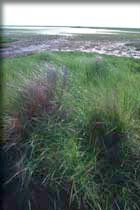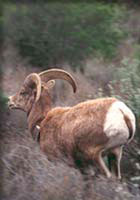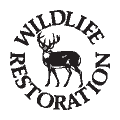
Tidal flats and green grass at
Peach Point WMA.

Bighorn sheep running across the grass at Elephant Mountain WMA.
Wildlife Management Areas of Texas
The rural landscape of Texas offers a natural beauty and character unsurpassed. Texas boasts some of the most beautiful and abundant populations of plants and wildlife to be found anywhere.
Past generations of Texas families lived in or near rural, natural areas of the state, and understood the value and necessity of healthy natural systems. But today most Texans live near cities and towns, and many of us have lost our connection with the land.
The Wildlife Management Areas (WMAs) of Texas offer a unique opportunity for the public to learn and experience the natural part of Texas and the systems that support life. WMAs are operated by the Wildlife Division of Texas Parks and Wildlife. Today, we have 50 Wildlife Management Areas, encompassing some 748,768 acres of land. WMAs are established to represent habitats and wildlife populations typical of each ecological region of Texas. Today, every ecological region in Texas is represented.
WMAs were established as sites to perform research on wildlife populations and habitat, conduct education and demonstrations of sound resource management techniques, and to provide public hunting, hiking, camping, bird watching and a host of other outdoor recreational opportunities — all of which are compatible with the conservation of this valuable resource.
WMAs offer a chance to experience Texas's natural beauty — from the high, wide skies of the Panhandle in the north, to the southern tropical thorn forests of the Lower Rio Grande Valley — and from the spectacular western vistas of the Trans-Pecos, to the lush green mystery of the Pineywoods in East Texas.
Visiting a Wildlife Management Area
Many WMAs are open for activities such as biking, primitive camping, birding, fishing, hiking, equestrian activities, driving tours, and wildlife viewing.
Note: Potable water for drinking or cooking is not available to the public on most WMAs.
Call ahead before visiting a WMA. Conditions, habitat work or hunting activities may restrict or limit recreational opportunities. Contact information can be found on each WMA page.
» Find a Wildlife Management Area
» Hunting Opportunities on WMAs and Required Hunting Permits
Habitats Technical Guidance
- Cross Timbers/North Central Texas Wildlife Management
- Hill Country Wildlife Management
- High Plains/Panhandle Wildlife Management
- Oak Prairie Wildlife Management
- Pineywoods Wildlife Management
- Post Oak Savannah Wildlife Management
- South Texas Wildlife Management
- West Texas - Trans-Pecos Wildlife Management
